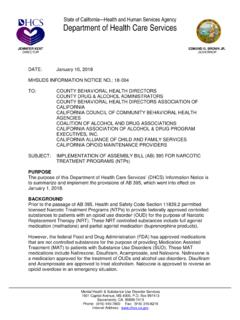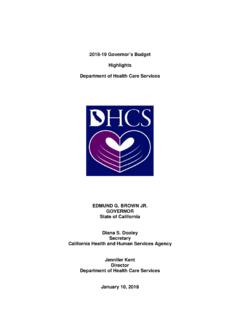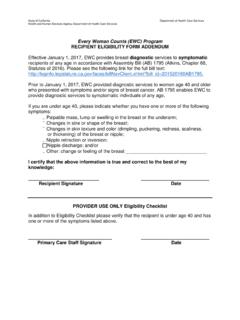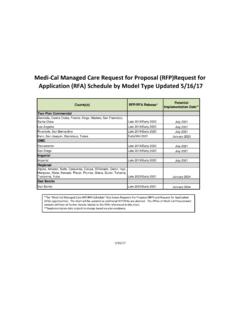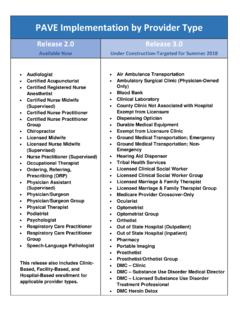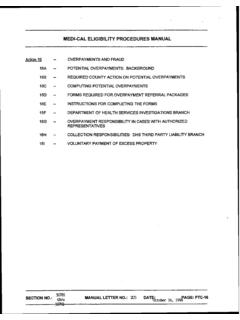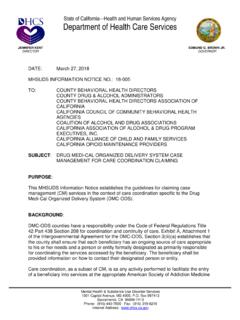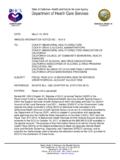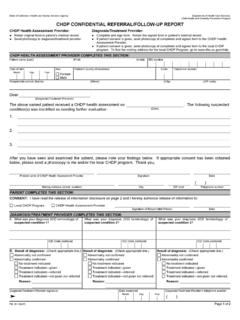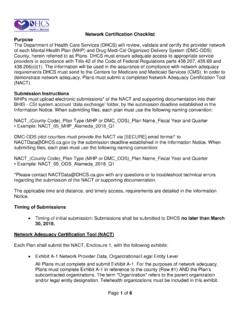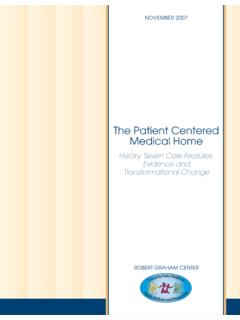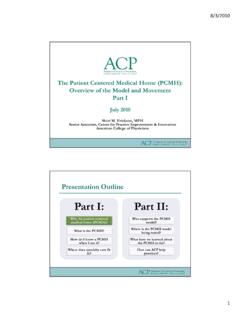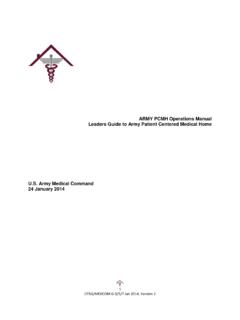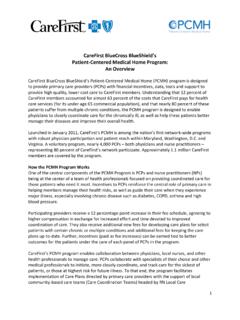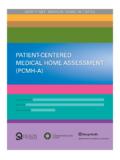Transcription of Patient-Centered Medical Home
1 1 Patient-Centered Medical home From Vision to Reality L. Gregory Pawlson, MD, Executive Vice President, NCQA Bruce Bagley, MD, Medical Director for Quality Improvement, American Academy of Family Physicians Michael Barr, MD, Vice President for Practice Advocacy & Improvement, The American College of Physicians Xavier Sevilla, MD, Member of the Steering Committee of Quality Improvement and Management, The American Academy of Pediatrics Phyllis Torda, Vice President for Product Development, NCQA Sarah Scholle, Dr. PH, Assistant Vice President for Research, NCQA Word Count: 4,091 2 Abstract (100 words): While the basic term Medical home is three decades old, a refined formulation, the Patient centered Medical home (PCMH), has been touted as an approach that could relieve the looming crisis in primary care, improve clinical quality and patient experience, and moderate cost increases.
2 This paper explores the concept of the PCMH, its relationship to the planned care model, the growing support for the concept from purchasers, consumers, physicians and insurers, and plans for demonstration and pilot projects in the private and public sectors. Finally some concerns that have been expressed about the PCMH are explored and policy implications noted. Key words: Patient centered Medical home , Primary Care, Quality of Care 3 Medical home : Concept and History The formulation of the patient centered Medical home outlined in this paper encompasses the clinician attitudes, knowledge, skills and the critical practice support systems that professional groups and others have identified as potentially leading to higher value care (enhanced quality and lower resource use) for patients with chronic illness or preventative service needs.
3 The first use of the term Medical home was in a book published by the American Academy of Pediatrics (AAP) in 1967 (1). The initial premise was that children with special needs (defined as children with severe chronic illness, developmental disabilities and birth defects or others with high care needs) should have care coordinated by a practice that provided accessible, coordinated, family centered , culturally effective care by a pediatrician who in addition provides primary care and manages and/or facilitates all aspects of the care for these children (2) . Projects implementing various aspects of the Medical home have occurred in a number of states supported in part by the Department of Health and Human Services Maternal and Child Health Bureau and linked to strong advocacy programs led by parent groups.
4 In recent years the AAP has broadened the focus to recognize that all children, given chronic care and/or preventive needs, are likely to benefit from care provided in Medical homes. The AAP has also created a web based resource center focused on the Medical home (3) . The American Academy of Family Physicians (AAFP), as part of its effort to define the future of family medicine created an expanded set of Medical home characteristics embedded in what the AAFP termed the personal Medical home (4- 5). A recent monograph from the AAFP s Robert Graham Center for Policy Studies describes in detail the links between the benefits of primary care and the PCMH concepts (6).
5 4 The American College of Physicians described the advanced Medical home in a position paper released in January 2006 (7)and then linked this model to a framework for reimbursement reform (8). I n March 2007, the AAP, AAFP and ACP, joined by the American Osteopathic Association (AOA), further refined the elements of the Medical home , including a greater focus on the patient s perspective , and applied the designation patient centered Medical home (PCMH) in a in a jointly published statement of principles ( 9). The key principles of the PCMH statement stipulate that PMCH practices will provide.
6 1) access to care based on an ongoing relationship with a personal physician who is able to provide first contact, continuous and comprehensive care, 2) care provided by a physician led team of individuals within the practice who collectively take responsibility for the ongoing needs of patients 3) care based on a whole person orientation in which the practice team takes responsibility for either providing care that encompasses all patient needs or arranges for the care to be done by other qualified professionals, 4) care coordinated and/or integrated across all elements of the complex health care system and the patient s community.
7 5) care facilitated by the use of office practice systems such as registries, information technology, health information exchange and other systems to assure that patients get the indicated care when and where they need and want it in a culturally and linguistically appropriate manner. Finally, the principles call for a reimbursement structure that supports and encourages this model of care. 5 Evidence of effectiveness of PCMH Because the formulation of the PCMH is relatively very recent, there is little published scientific evidence of its overall effectiveness. However, there is substantial evidence for the effectiveness and importance of many of its key characteristics given that most of them align with the empirically derived framework of the Wagner Chronic Care Model (10).
8 This model is based on a substantial and growing body of literature that has linked use of clinical information systems and registries, decision support, performance measurement and feedback, delivery system interventions and patient self management support to improved clinical outcomes and patient experience of care (11- 12). Additional studies, including RCT s of various components, such as quality measurement, benchmarking and feedback also have been published (13-16)). The Community Care of North Carolina (CCNC) project implemented in 94 counties across North Carolina which has modeled an approach incorporating many of the principles of the PCMH for NC Medicaid patients (650,000) has posted data on two evaluation studies (17).
9 These evaluations based on changes in historical trends suggest substantial cost savings to the state Medicaid program. Beyond the cost savings, the program has also identified substantial improvements in the quality of care for Medicaid patients with asthma, congestive heart failure and diabetes. Similarly in pediatrics there have been studies published documenting positive impact of the Medical home as formulated by the AAP, including an RCT and evaluation of two Medical home Learning Collaboratives conducted by the National Initiative for Children s Healthcare Quality and the Maternal and Child Health Bureau showing a decrease of Emergency Department visits, unplanned Hospitalizations, missed school and work days for Children with Special Needs with increasing Medical home principle adoption by practices ( 19).
10 A recent study published by the Commonwealth Fund suggests that the PCMH may also have a role in reducing disparities. Their study, in which the definition of Medical home referred to a 6 practice that offers patients a regular source of care, enhanced access to physicians, and timely, well-organized care (based on a patient experience of care survey), revealed that patients who reported having access to their definition of a Medical home received a higher level of preventive and chronic illness services regardless of insurance status, race or gender versus patients cared for in practices that lacked those characteristics (20).
